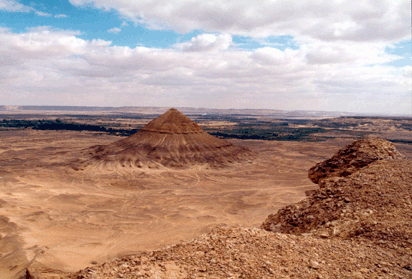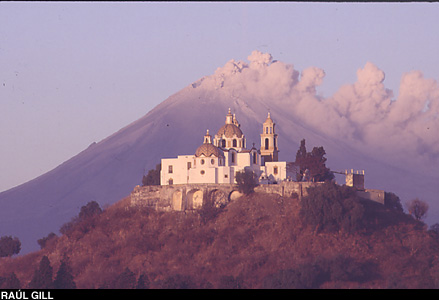I will keep adding to this post as I find more information or as more ideas spring to mind. Please bare in mind the world has thousands of pyramids and their locations mostly correspond with the locations of volcanoes.
My main thought for now is that it seems the Egyptians were as much aware of their volcano worshipping heritage as were the Hebrews of the later eras in the Old Testament. They had moved away from their volcanoes to more hospitable land, as had the Hebrews, but the terminology remained. This detachment from deity is, I feel, critical to the survival of the beliefs or at least the mystery. If the deity can be seen, there is no mystery.
Jebel Dist, Pyramid Mountain, The Black Desert, Egypt
Jebel Dist, by tourists also called the Magic Mountain or the Pyramid Mountain because of its symmetrical sides and pointed peak is located some 17 km north of town of Bawiti. It offers impressive views of the oasis, desert, and 1000s of palm trees. Some archaeologists believe that Jebel Dist served as a model for the man-made pyramids. In 1914, German paleontologist Ernst Stromer von Reichenbach found remains of dinosaurs in the area of Jebel Dist and a neaby Jebel Maghrafa.
Please also see...
Pyramid Mountain (Gebel Dist): Just northeast of the Oasis, many archaeologists have speculated that mountains such as this one, were the inspiration for pyramid building. Dinosaur remains have been uncovered here.
Either this mountain is a volcano or it is a very pyramidal looking mountain surrounded by volcanoes.
Map of Volcanoes of Africa taken from here.
The most likely site for Punt, the place the ancient Egyptians called 'God's Land' or 'Land of the gods', is Djibouti, the reddest area on the map above, the red triangles markers of volcanoes.
The word Pyramid is said to be derived from the Greek, ‘Piramis’ and ‘Piramidos’, translatable as ‘Fire in The Middle’. This concept of ‘fire in the middle’ seems strange, but could the symbolism in resemblance between an erupting volcanic mountain and a pyramid be a valid supposition?
According to Ancient Egyptian cosmology the pyramid symbolically represented the primeval hill rising from the watery mass. (See the Biblical Leviathan, a submarine volcano)
http://www.kaa-umati.co.uk/pyramid_decoded%20part%202.htm
According to Ancient Egyptian cosmology the pyramid symbolically represented the primeval hill rising from the watery mass. (See the Biblical Leviathan, a submarine volcano)
http://www.kaa-umati.co.uk/pyramid_decoded%20part%202.htm
Very soon, as we got closer, walking around them and observing them at different times of day, one thing became obvious: all the pyramids built around the slopes of Mount Etna had been built by the same civilization, with the same type of lava stones in the same arrangement, with the corners built in the same way. We realised that there were several styles of pyramid, spread all around the volcano.
The Mayans believed that they could delay or prevent the eruption, having performed blood rituals and fed the spirits and gods to monitor volcanoes. "They have built temples in the form of volcanoes and rituals were, like volcanic events. Volcanoes have been an integral part of Mayan life, " said Tankarsli.
In Egypt, I have mentioned the glyph Akhet which is often translated as "horizon." However, at times the glyphs refers to the "Mountain of Light" in Egyptian cosmology, or to pyramids or temples as in Akhet Khufu "the Pyramid of Khufu."
Great Pyramid of Cholula with volcano in background
In foreground, the seventeenth-century sanctuary of Nuestra Señora de los Remedios sits atop the Great Pyramid of Cholula, the largest pyramid in the Americas. The pyramid echoes the contours of Popocatépetl, and some believe its Indian name, Tlachihualtepetl ("Man-made Hill"), reflects the imitative effort of those who built it. Perhaps construction of Cholula's Great Pyramid, which echoes the contours of Popocatépetl and may have started at this time, was at least in part an attempt to appease the mountain.
Here are some exerts from a long and interesting article by Avry Wilson. You can read it in its entirity here.
But as destructive as these can be, the true king of local ecosystem obliteration is, was and always will be the volcano. It is also set apart from the others because (ironically) in the wake of an eruption comes new life, as we shall see. The ancients knew nothing of meteorology or geology – they simply saw in their environment the will of the gods being acted out in brutish, devastating reality. From this, myths were born.In a nutshell, the prehistory of northeast Africa’s indigenous population would have gone something like this: First, pushed away by the hyperaridity of the Sahara during the LGM and on until the onset of the Holocene, communities settled around wetter and warmer areas, which in the case of eastern-central Africa happened to include volcanic fields of activity. Second, with the advent of a greener Sahara in the first couple of millennia of the Holocene Era, people re-inhabited the northern expanse in greater numbers, bringing with them memories of where they came from.Lastly, toward the age when true civilizations began to form c.5-6kya, hyperaridity returned to the Sahara and the diasporas spread to the desert’s outer rim once again, settling for good among the surviving oases (like Dakhla, Kharga, and Farafra), the Nile Valley, and so on. But like the hardier types mentioned earlier, not all sought refuge in greener environments; those with good survival skills and a fair serving of intestinal fortitude stayed on at remote locations in the eastern desert of Egypt (for instance at Gilf Kebir). Indeed, studies of ceramics [Lange: 2000] found at desert locations have proven to be the original source of certain styles only seen later on in ancient Egypt. This in itself tells us that at least a portion of their history has its roots outside of the Nile Valley, providing further testimony how distant legend and myth also made its way to the river. But ceramics are only part of the tale because of the hint of earlier mummification found in the desert (i.e. the ‘Black Mummy’ exposed recently by Savino Di Lernia of the University of Rome) and the fascinating and archaic rock art found all over northeast Africa which presumes an early source for what would later become the ancient Egyptian hieroglyph writing system. Because of these ample archaeological results outside of Egypt which suggest a root of influence, the next question concerns what exactly would have been the inspiration for volcanic allusions found in ancient Egyptian tales and religious texts.
(My note.....the Black Desert in Egypt can be seen here.)
In the Pyramid Texts we find the king ascending to the sky in what appears to be an unusual way. Normally consistent throughout these archaic texts is that the king ascends by means of the air, an ethereal ladder, a ‘sun’ barque and so on.“ … the sky thunders, the earth quakes, Geb quivers, the two domains of the god roar …”“ … while Geb, with one arm to the sky and the other to the earth, announces me to Re [the sun god] … ““ … I am the flowing fluid, I have issued from the creation waters; I am a snake, multitudinous of coils; I am this head-band of red colour … ”“ … Fifty cubits along its side are fire, the tip of its flame crosses the land from the sky and the gods have said of it: ‘It means blackness(?)’ …”
(My note....one thing overlooked is that the creation volcano that is described here rising from the waters could well have been a submarine volcano. Most volcanoes are submarine.)
Etymologists and enthusiasts alike have had a hard time when trying to define the origin of the term ‘pyramid’. In this form it is Greek, and many have noted the prefix of ‘pyr’ (Greek for ‘fire’) but none have made the connection to a ‘volcano’ theme. The actual, purer Greek form of the word is ‘pyramis’, meaning ‘bread’. How to resolve the question of why the Greeks chose the term ‘pyramid’ as a label for these great heaps of stone comes in what bread is. Bread is baked to ‘rise’ from heat/cooking. This reads into a volcano well in how it rises/ascends from/with heat.
(My note.....the correlation to bread goes further as both bread and volcanoes not only expand and rise up but also split open at the top allowing steam/ash/fire to escape.)
Looking even closer at the pyramids of ancient Egypt sheds light on possible volcanic influences. For example, the truncation of a pyramid mimicking the ‘loss’ of the top of a volcanic peak. Or, we can appreciate a dual meaning for the shafts within the Great Pyramid, where one instance is as a metaphysical aid for the pharaoh’s soul to the reach the sky, while the other suggests a reference to the focused expelling of tephra through mountainside vents, with the similar aid of transporting the soul from within to the sky.
Please read all of Avry Wilson's article here and pass it on.
Information on pyramids in volcanic Mauritius, Tenerife and Sicily.....from here.....
In January 2008 Antoine Gigal and her team re-discovered the existence of 7 Pyramids on Mauritius Island. In appearance, they are similar to the pyramids located on another volcanic island off the western – coast of Africa, Tenerife; similar structures also exist on the Mediterranean island of Sicily, which is also volcanic in origin. There are many parallels between the pyramids of Mauritius and Tenerife. On both island, the pyramids are part of a complex: a series of pyramids grouped together in one location. On both islands, the pyramids are made from lava stone and the construction does not use any mortar or other connecting agent.
A pyramid has been discovered of the coast of Portugal on an underwater volcanic hill. Researchers are hopeful this pyramid might be part of the lost Atlantis. My thoughts are there are many Atlantis wrecks lying on our sea beds due to volcanic islands suddenly sinking into the sea, taking the civilisations with them.
I posted the following two part video in August but as it's relevant to this post I'm adding it again....
Buy Bill Lauritzen's book here for just over 9 dollars!
The Pyramid Decoded.....in full here....
In
many ways the configuration of a pyramid closely resembles the natural form of a
volcanic mountain erupting and spewing out fiery matter from the interior and
pushing it upwards thus forming a mound. The
word Pyramid is said to be derived from the Greek, ‘Piramis’ and ‘Piramidos’,
translatable as ‘Fire in The Middle’.
New information on the connection between pyramids and volcanoes....
http://warwickshirewicca.blogspot.com/2014/10/volcanoes-and-shamans.html?showComment=1440725871727#c2634276822159282224
I will add more to this article ASAP but, in the meantime, please go through my blog which covers the theory the ancient Hebrews worshipped volcanoes....starting here.


